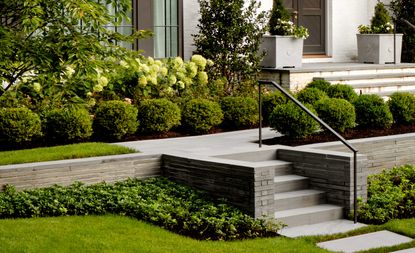Should I deadhead my hydrangeas? How to do it (and when) for healthy, good-looking plants
Expert gardeners offer their best advice on how to prune and deadhead your hydrangeas to keep them looking gorgeous


Hydrangeas are one of the most popular flowers to plant in a yard, across different landscaping styles. Their wonderful blooms bring joy to any space, feeling pared back in a contemporary garden, while they flourish extravagantly in a more maximalist planting scheme. All that, and they're relatively low-maintenance, too.
As perennials, hydrangeas do go dormant in winter, however with the right care their blooming season can be extended well into fall. With such beautiful flowers blooming in a modern garden, it can be daunting to put the shears to them and say goodbye to their flowering season. It is always a question of "will they grow back?", however it needn't be.
We have entailed the help and expertise of professional gardeners to walk us through the steps of deadheading hydrangeas - these are the tips and tricks to keep your flowers looking their best and ensure they come back better than ever.
Should I deadhead hydrangeas?
Pruning and deadheading are established words in the gardener's dictionary, however, it can also be one of the top mistakes made by beginner gardeners to go at your plants with the shears when you don't need to. In order to prune successfully we must understand why it is so important.
'Deadheading, the act of removing spent flowers, is a fundamental practice that offers numerous benefits to your hydrangea plants,' explains plant expert Zahid Adnan of The Plant Bible.
Deadheading the older blooms is important for the future health of your hydrangeas. 'By removing faded or wilted blooms, you encourage the plant to put its energy into producing new buds rather than expending resources on producing seeds,' says Zahid. 'This results in a more prolonged and vibrant flowering period, enhancing the overall aesthetic appeal of your garden.'
If you are looking to extend the life of your flowers well beyond the end of summer you will want to be incorporating pruning into your backyard maintenance routine.

How do I deadhead hydrangeas?
Deadheading can be a simple and quick process, once you know how - and the steps are the same for potted hydrangea care and those in flower beds. Luckily the gardening activity requires tools you will most likely already have. 'Deadheading hydrangea is a straightforward process that requires just a few basic tools: a pair of sharp, clean pruners and gardening gloves,' says Zahid.
Before picking up the pruners, it is important to inspect the blooms to correctly identify the spent flowers. 'You are looking for flowers that have begun to wither and lose their vibrant color,' explains Zahid.
'You should just cut off the spent flowerhead and the portion of stem immediately below it,' says gardener and writer Martin Cole of Gardening Step by Step. 'To make the cut, look down the stem to find a set of large, healthy leaves. Make your cut just above this set of leaves. This can potentially stimulate new growth leafy growth.'
Wonderful, full flowers are a great addition to any garden. To ensure they are kept this way there are some things to consider when deadheading. 'When you are cutting ensure you make a clean, diagonal cut. This angle prevents water from pooling on the cut surface and potentially causing rot,' advises Zahid.
When looking for flower heads that are past their best, make sure you don't get too heavy-handed. Hydrangeas form in clusters but there are individual groups within that. 'For hydrangeas with clustered blooms (like mophead hydrangeas), deadhead each individual spent flower within the cluster,' Zahid says. 'Be cautious not to damage emerging buds.'

Size: one gallon
Price: $59.95
When should you deadhead Hydrangeas?
Choosing the right time to deadhead your plant is essential to maximize the effectiveness of your work. As a low-maintenance garden idea, it will also help to keep their care levels lower, so that you can do it once and forget about them for now. There are a few things to consider when deciding when the optimal time is.
'The timing of deadheading depends on the type of hydrangea and its flowering habits,' says gardening expert and flower aficionado Alex Tinsman. 'For hydrangeas that bloom on old wood, like mophead and lacecap varieties, deadheading should be carried out right after their flowering phase, typically in late spring or early summer.'
'Conversely, hydrangeas that bloom on new wood, such as panicle and smooth hydrangeas, are best deadheaded in late winter or early spring before new growth emerges,' he explains.
Before you start your gardening, research your specific variety as it will help to determine what is best. However, you can also use your gardening knowledge to follow the visual cues to indicate when deadheading is necessary. 'As the once-vivid blooms start losing their vibrancy and their hues begin to diminish, it's time to consider the task,,' Alex says. 'Regular inspection of your hydrangea plants will enable you to discern the appropriate timing for deadheading.'

Size: mature 3-4ft tall
Price: $59.99
When shouldn't you prune hydrangeas?
'While deadheading is generally beneficial, there are a few instances when you should refrain from this practice,' warns Zahid. There are a few deadheading mistakes you will want to avoid to ensure you are giving your hydrangea plant the best opportunity to thrive and produce long-lasting healthy blooms.
Using blunt tools, pruning too excessively, and forgetting to collect seeds are some of the generic mistakes made when deadheading. However, there are also specific circumstances relating to hydrangeas to consider.
'If the spent blooms are still attractive, it is wise to leave some blooms on the plants,' says Martin. 'They provide winter interest, and the dried blooms offer some protection from frost for the emerging buds below them.'
Many gardeners like the look of dried flowers during the autumn and winter, leaving them on will not damage your plant as you can simply revive them before spring. Hydrangeas provide beautiful flowers for much of the year, it can be sad to see them go. Follow these simple tips to deadhead your plant to ensure it comes back bigger and better than ever the following year.
Tools you may need

Size: 75"L X 6"H X 1.75"W
Price: $12.99

Material: bamboo and rubber
Price: $9.49

Size: 11 gallons
Price: $13.99
Be The First To Know
The Livingetc newsletter is your shortcut to the now and the next in home design. Subscribe today to receive a stunning free 200-page book of the best homes from around the world.

Amy recently completed an MA in Magazine Journalism at City, University of London, with experience writing for Women’s lifestyle publications across arts, culture, and beauty. She has a particular love for the minimalist aesthetic mixed with mid-century furniture, especially combining unique vintage finds with more modern pieces. Her previous work in luxury jewellery has given her a keen eye for beautiful things and clever design, that plays into her love of interiors. As a result, Amy will often be heard justifying homeware purchases as 'an investment', wise words to live by.
-
 How to Thaw a Frozen Pipe — Learn Everything You Need to Know in 5 Minutes With This Guide
How to Thaw a Frozen Pipe — Learn Everything You Need to Know in 5 Minutes With This GuideWinter storm caught you off guard? We asked an expert — just how do you thaw a frozen pipe?
By Hugh Metcalf Published
-
 The 12 Very Best Silk Bedding Pieces — As Our Style Editor Says: 'It's What Dreams Are Made Of!'
The 12 Very Best Silk Bedding Pieces — As Our Style Editor Says: 'It's What Dreams Are Made Of!'Slumber in lustrous luxury with the very best silk bedding sheets, duvets, pillowcases, and more — your sleep score will thank us later
By Julia Demer Published

